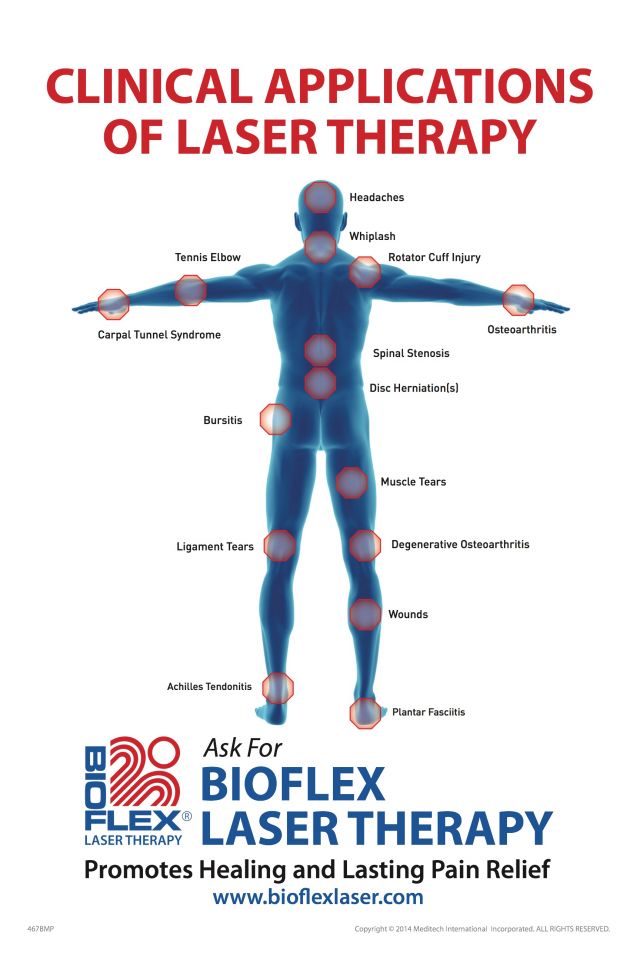Corinne Baht Therapy
https://bioflexlaser.com/the-science/

BIOFLEX Science
Compared to traditional treatment, patients recover from musculoskeletal and peripheral nerve injuries with less scar tissue, accelerated cell regeneration, and improved function.
What is Laser Therapy?
Laser Therapy is known by many terms, including cold or low-level laser therapy (LLLT). Recently, experts have chosen photobiomodulation therapy (PBMT) as a more accurate term that describes the therapeutic use of red and near-infrared wavelengths of light energy from laser OR light emitting diodes (LEDs) that interact with photoreceptors to produce photochemical reactions that have a positive effect on cellular metabolism and recovery from damage and inflammation.
More Info
Light Spectrum in Laser Therapy
The effectiveness of wavelengths of light with respect to photobiomodulation therapy can be characterized by the action spectra of the target photoacceptors (e.g. cytochrome c oxidase), that determine the positive biological responses such as increased metabolism, cellular regeneration and immunomodulation. The most clinically effective wavelength ranges are in the red (630-680 nm) and near infrared spectra (810-840 nm). Wavelength is one critical parameter of light among other factors such as dosage or energy density (J/cm2), treatment time and light delivery in pulses (cycles per second or Hz) in determining the efficiency of absorption, depth of penetration and ultimately the clinical outcomes. The effects of photobiomodulation are cumulative and can be clinically evident immediately after treatment or over a period of days.
More Info
Clinical Effects of Laser Therapy
Class III vs Class IV Lasers
Class 3B
5-500 mW Athermal Lower Energy and longer treatment duration optimizes healing and anti-inflammatory effects.
Class IV
>500 mW Thermal High energy and longer wavelengths result in tissue heating and less penetration.
The medical subject headings (MeSh) for Laser Therapy is now called photobiomodulation therapy (PBMT). Light emitting diodes (LEDs) and other sources of light have been proven to be clinically effective so referencing only lasers is not accurate anymore. The definition of PBMT mentions that if lasers are used they must be less than 500 mW to avoid a thermal reaction and inhibition of healing. Thus, any single laser diode with the goal of photobiomodulation should be a Class 3B when contacting the skin to ensure optimal penetration and provide enough stimulatory healing energy but not cause thermal tissue damage.
More Info
The therapeutic effects of Laser Therapy at the cellular level have proven to increase ATP levels and DNA synthesis and are specific to enhance mitochondrial membrane potential and function. The light emitted using the various laser therapy systems stimulate the photochemical reactions within the cells supporting mitochondrial activities. This can create beneficial changes in cell behavior and accelerate the natural healing process. Mitochondria contain photoreceptors that absorb the photons from light and convert these into ATP – energy that can be utilized to stimulate cellular activities and biological processes. Proper mitochondrial function and ATP production are critical to the process of neuro-protection modulation, regeneration, cognitive enhancement, and the prevention and alleviation of a number of other neurological pathologies. Laser Therapy is effective in:
BIOFLEX Laser Therapeutic Platforms
Musculoskeletal Injuries
The most common applications are muscle strains, ligament sprains, tendinopathies, cartilage tears bursitis and other injuries to the musculoskeletal system. Whether it’s a sports injury, overuse condition, or an accident, the goal of treatment is to accelerate the healing process and decrease symptoms which allows the clinician to initiate manual and exercise therapies much sooner.
Wound Healing
BIOFLEX Laser Therapy has been proven to accelerate surgical wound healing, dermal ulcers, diabetic lesions and all other recalcitrant wounds. This results in increased angiogenesis, neovascularization, collagen secretion and decreased inflammatory exudate and provides epithelization of the wound, improved arterial perfusion and, regeneration of the local and regional tissues.
(Professional Systems)
Arthritis
Chronic progressive forms of joint degeneration can be effectively managed with BIOFLEX Laser Therapy. All of the arthritides from early to late stages will respond to treatment resulting in decreased pain, inflammation, stiffness and edema. Research has even shown repair and regeneration of eroded hyaline cartilage when exposed to Laser Therapy.
(Professional Systems)
Nerve Healing
From diabetic neuropathy to discogenic radiculopathy to carpal tunnel syndrome, BIOFLEX Laser Therapy can accelerate nerve healing and decrease paraesthesia and nerve pain as a result of direct absorption of light. Many peer reviewed clinical trials and lab studies have proven Laser Therapy is an effective therapy for nerve healing and has no known side effects.

